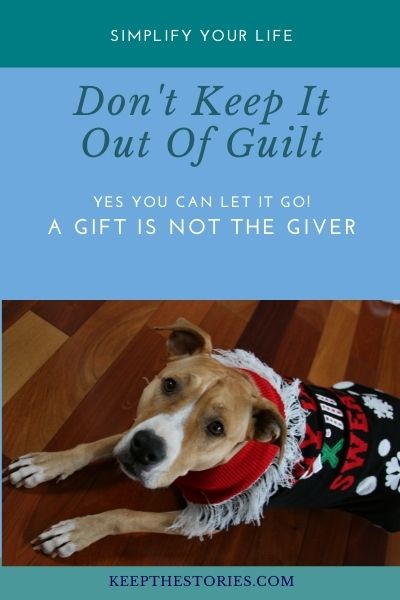The reality is that at some point, it is no longer practical, healthy or reasonable to hold on to things you don’t need simply because you’re trying to hold on to a memory.
Ruth Soukup, Living Well, Spending Less
Yes, You Can Let That Go
People Are Not Their Stuff
All our possessions are not created equal. We each have some things that are harder to let go than others. Usually, that is because of an emotional attachment that we have with some possession.
We attach sentiment to our stuff for a variety of reasons. It might be because of association with a childhood memory or a connection with the person who gave it to us. Those items can have an enormous emotional connection that often results in a feeling of guilt when we think of letting these possessions go. It is important, however, to consider how holding onto things solely because you feel guilty can contribute to dissatisfaction or stress.
Here are some tips that might help you more easily make a decision when you are waffling on letting go because of guilt or emotional attachment.
We Are NOT Our Stuff
It is often natural to link possessions with our sense of self-worth and identity. We see the things we own as part of us, and a reflection of our personality and character. One approach to breaking this connection is to remember that we are not our stuff. Sure, something can be a strong reminder and trigger special memories but just because something holds memories or significance does not mean that you have to keep the object itself. Take some steps to record the reasons an object is important to you – take pictures or scan documents. Write a description of the memories, which can be as simple as bullet points on an index card or as involved as several journal pages or even a short story. Keeping curated photo albums or digital files takes less physical and emotional clutter. You can acknowledge the importance of the item, record it, then release the object to a new home without feeling that you are also relinquishing the memory.
A Gift Is NOT The Giver
Similar to the last point, we often see people that we love in things that they have given us. This can be especially powerful when it is a person who is no longer physically present in our lives.
It can be hard to let go of a gift that someone has given, even if it is not to our taste or a fit with our lifestyle. Sometimes, we keep things because we don’t want to hurt someone’s feelings or have them think that we are ungrateful. Those are kind and thoughtful reasons but there are times when keeping the item causes you stress. It might be something that does not ever suit or it might be that your interests and priorities have changed and you no longer value the same things.
How you deal with that connection might depend on the person and your relationship. If the giver is no longer with you, you do not need to worry about hurting them so you have to release yourself of that guilt. It can help to think about the person who gave you the gift and understand that they would not want you to feel you had to hold on to something that does not bring you joy. You can remember the person without that object and, again, you can take pictures and write the importance of the memories. It can also help you to pare down if you keep just one item from each significant person or event.
If the gift is from someone who is still in your life, you still have to make choices that align with your life. In some cases, that might mean that you have to have difficult conversations with friends and family if they later ask why you never use/ wear…. something that they gave you. You will need to decide how best to respond but usually, you can gently explain that you love them for getting it for you and appreciate it and the gesture but you don’t have room or it doesn’t suit or whatever the situation. Perhaps, you can keep a picture and note on the back when you got it and from whom and what you did with the item and you can share that to show that it was meaningful.
Memories Are What Matters
It’s the memories that matter most. You don’t always need to keep the physical possession in order to hold onto its emotional significance. When you are struggling to let go of a particular item, consider it carefully and ask yourself:
- Does this bring me happiness or calm?
- Can I incorporate this in my life and home?
- Does it have a story that I want to remember that I need this item to tell?
The answers to these questions can help with the decision to let something go.
Letting Go Is Freeing
Making purposeful choices about what items to keep and what to release can be liberating! It can make you feel lighter and freer. When you understand your priorities and intent and act in alignment with them, you’ll be more content with your decisions. You’ll also be happier with the outcome as you reduce your clutter.
Donating items to those who may really need or appreciate them is also uplifting and freeing. Perhaps you know someone who is starting a new life and could use some household goods or maybe you have a friend who is a collector that would truly appreciate your father’s collection of antique watches. It can be easier to release things when you know are going to a new home where they will be appreciated – and this would also probably have pleased the original owner or gift-giver.
Living your life with intention and purpose applies to all facets of your life – including letting go. Making considered decisions about what to keep – or not keep – can lift your spirits AND clear your space.
Take Action
Keep these tips in mind when deciding whether to get rid of sentimental items. You don’t have to allow guilt to keep you trapped in an overabundance of possessions and clutter. You’ll feel better when you’ve found ways to intentionally remember your loved ones.
Challenge Questions for Day 24
Is guilt a big challenge for you when you are trying to declutter or do you find you are able to separate the item from its story?
What strategies do you use to capture memories and help release the stuff?
Declutter Challenge for Day 24
Capture the Story of One Item
Identify one item that you are keeping only because of guilt or a sentimental connection. Take pictures, write the stories, even it is just bullet points that you are afraid you might forget if you let the object go. Decide if you will keep and use or display the item. Tink of what you might do with it. Do you want to use or display it? Is it an item that someone else in your family might value? Can it be upcycled or repurposed? Can you sell or donate? Can it be used for parts?
Make a plan of action and take a step to make it happen.
Banner Photo by RODNAE Productions from Pexels



0 Comments